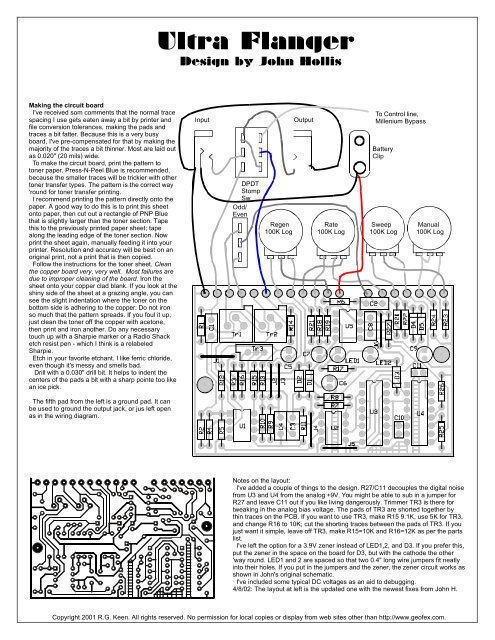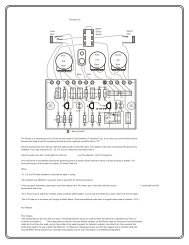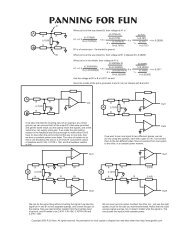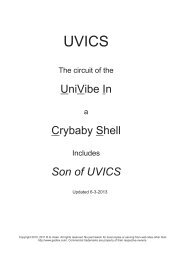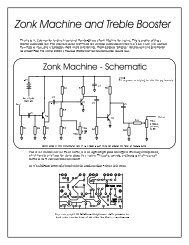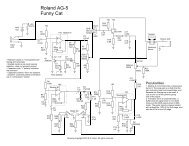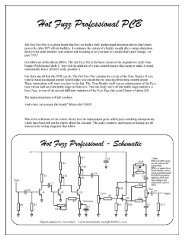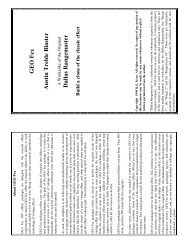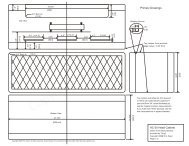Create successful ePaper yourself
Turn your PDF publications into a flip-book with our unique Google optimized e-Paper software.
<strong>Ultra</strong> <strong>Flanger</strong><br />
Design by John Hollis<br />
Making thecircuit board<br />
I've received som comments that the normal trace<br />
spacing Iuse gets eaten awayabit by printerand<br />
file conversion tolerances, making the pads and<br />
traces abitfatter. Because this is avery busy<br />
board, I've pre-compensatedfor that by making the<br />
majority of the tracesabit thinner.Most arelaid out<br />
as0.020" (20mils)wide.<br />
Tomake thecircuit board,print the pattern to<br />
tonerpaper.Press-N-Peel Blue is recommended,<br />
because the smaller traces will betrickier withother<br />
tonertransfertypes. Thepatternis thecorrectway<br />
'round fortonertransfer printing.<br />
Irecommend printing thepatterndirectly ontothe<br />
paper. Agood way todo this is to printthis sheet<br />
onto paper,then cut out arectangle of PNP Blue<br />
that is slightly larger than the toner section. Tape<br />
this to the previously printed paper sheet; tape<br />
along theleading edge of the tonersection. Now<br />
printthe sheetagain, manually feeding it into your<br />
printer.Resolution and accuracy will be best on an<br />
original print,not aprint thatis then copied.<br />
Follow the instructions for the toner sheet. Clean<br />
the copper board very,very well. Mostfailures are<br />
due to improper cleaning ofthe board. Iron the<br />
sheet onto yourcopperclad blank. If you look atthe<br />
shiny sideof the sheet at agrazingangle,youcan<br />
see the slight indentation where the toner on the<br />
bottom side is adhering to the copper.Do not iron<br />
somuch thatthe pattern spreads. If you foul it up,<br />
justclean the toneroff the copperwith acetone,<br />
then printand iron another. Do any necessary<br />
touch up withaSharpie marker or aRadio Shack<br />
etch resistpen -which Ithink is arelabeled<br />
Sharpie.<br />
Etchin your favoriteetchant. Ilike ferric chloride,<br />
even though it's messy and smells bad.<br />
Drillwith a0.030" drillbit.It helps to indent the<br />
centers of the pads abit withasharp pointe too like<br />
anice pick.<br />
Input<br />
DPDT<br />
Stomp<br />
Sw<br />
Odd/<br />
Even<br />
Regen<br />
100KLog<br />
Output<br />
Rate<br />
100KLog<br />
ToControlline,<br />
Millenium Bypass<br />
Battery<br />
Clip<br />
Sweep<br />
100KLog<br />
Manual<br />
100KLog<br />
The fifth pad from the leftisaground pad. Itcan<br />
beused to ground the outputjack,orjus left open<br />
asin the wiring diagram.<br />
Notes on the layout:<br />
I've addedacouple of things to the design.R27/C11 decouples the digital noise<br />
from U3 and U4 from the analog+9V.You mightbe able to sub in ajumperfor<br />
R27and leave C11 out if you like living dangerously. Trimmer TR3 is there for<br />
tweaking in the analog bias voltage.The pads of TR3 are shorted togetherby<br />
thin traces onthe PCB. If you wantto use TR3,make R15 9.1K,use5Kfor TR3,<br />
and changeR16 to 10K; cutthe shorting traces between the pads ofTR3. If you<br />
justwant it simple, leaveoffTR3, makeR15=10K and R16=12K as per the parts<br />
list.<br />
I've leftthe option for a3.9V zenerinstead ofLED1,2, and D3. If you preferthis,<br />
put the zener in the space on the board forD3, butwith the cathode the other<br />
'way round. LED1 and 2arespaced so thattwo 0.4" long wire jumpersfit neatly<br />
into theirholes.Ifyou put in thejumpers and the zener, thezenercircuitworks as<br />
shown in John's original schematic.<br />
I've included some typical DC voltages as an aid to debugging.<br />
4/8/02:The layoutatleft is the updated onewith the newestfixes from John H.<br />
Copyright 2001 R.G.Keen.All rights reserved. No permission forlocal copies ordisplayfrom web sites other than http://www.geofex.com.


